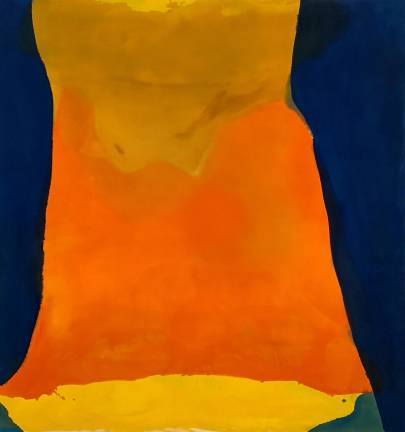living color

Sometimes, it’s more than enough for an exhibition to offer an extraordinarily beautiful moment. “Spilling Over: Painting Color in the 1960s” at the Whitney does just that as it radiates with color, line, and exuberance. There are plenty of “isms,” history, context, and voices to connect with, but the overall experience is one of exhilarating, ebullient beauty. Culled from the museum’s permanent collections and spaciously arranged, 18 works by 18 artists fill the top floor’s sunny galleries. Some have been at the museum for decades; some are new acquisitions. Some are by well known artists; some are by artists who deserve to be better known.
Frankenthaler the PioneerPerhaps the best way to see the show is to stand in the center of each gallery and just turn in place. The spilling-overness of the colors permeates the spaces and touches the spirit. Then, there’s plenty of time to step up to each work, look carefully, read the label, and let it speak to you. Helen Frankenthaler’s 1966 “Orange Mood” has a magnetic charge that draws you from across the room. Frankenthaler, like Jackson Pollock, liberated paintings from the easel, laying canvas on the floor, and then pouring, pulling, puddling and painting with thinned, vibrant acrylics. Rich oceans of lapis create a channel for a rising swell of warm golden oranges. The “mood” was hers when it was made. Now it’s yours for reflection.
Frankenthaler pioneered the use of poured stains and the genre of Color Field Painting, which resisted a central object, seeking instead to create works that transcended the limits of the canvas. She influenced Morris Louis and Kenneth Noland, both on view here. Noland’s 1967 “New Day” opens the show, and Louis’s rainbow ribboned “Gamma Delta,” from a few years later, faces “Orange Mood.”
An Early Feminist, and DebutsMiriam Shapiro’s lively geometric abstraction, “Jigsaw,” fits pieces of pure color into an almost-square format. An early feminist artist, her later pieces utilized fabrics, referencing quilts and other fiber arts generally thought of as women’s work. She described the colors in “Jigsaw” as “blinding and high-keyed, enough so as to optically distort the form.” Still, it’s not hard to see an abstract figure, a quilt block, and one of the colored wooden puzzles popular in those days in her bright star-shaped pattern.
Stepping away from abstraction, Kay Walking Stick’s “April Contemplating May” is from 1972 (just a bit beyond the ‘60s) and it’s making its debut appearance at the museum. “It’s a picture of two women in a space defined by color. And they are in color ... I was trying to create space primarily through color,” she says in a video that accompanies the exhibition online. Another figurative work appearing for the first time at the Whitney is “Baby” a 1966 painting by Emma Amos. Supercharged hues in the background blend with dark blue glasses, a cornflower speckled dress and the brown skin of the central figure, turning the portrait to a kaleidoscopic image. The wall text notes that Amos once said, “Every time I think about color it’s a political statement.”
Undercurrents and HarmonyAlso making a political statement through color is Frank Bowling’s painting, “Dan Johnson’s Surprise.” Territories, mapping, whitewashing, borders and color are expressed through three floating outlines of South America on a fluid background edged with red, yellow and blue. The title refers to Daniel LaRue Johnson, a mid-century African American artist who studied in Paris, while the shifting, unfocused shapes hint at continents, borders and nations eradicated or altered by colonialism and the slave trade.
These works express some of the zeitgeist of the 1960s, with counter-cultural, political, social and technological undercurrents. While distinct voices sing, there’s a harmony with plenty of grace notes coming through. Optical illusion, psychedelic visions, civil rights, feminism, protest, challenge, abstraction, pushing boundaries, and seeking new visual vocabularies are part of the dynamic energy in the exhibition. “It’s kind of a gathering of different artists,” says curator David Breslin, adding “Color is really the animating factor.”